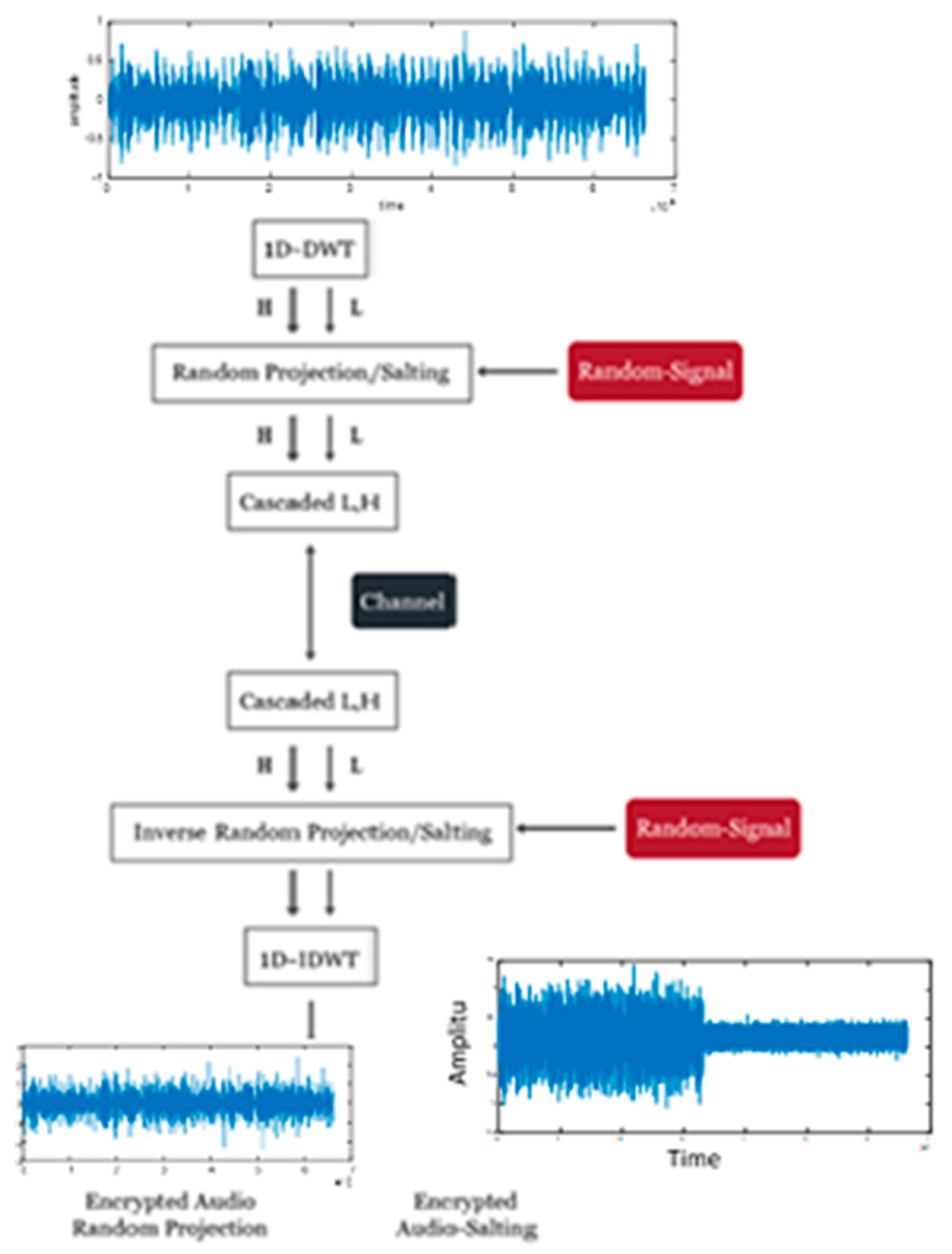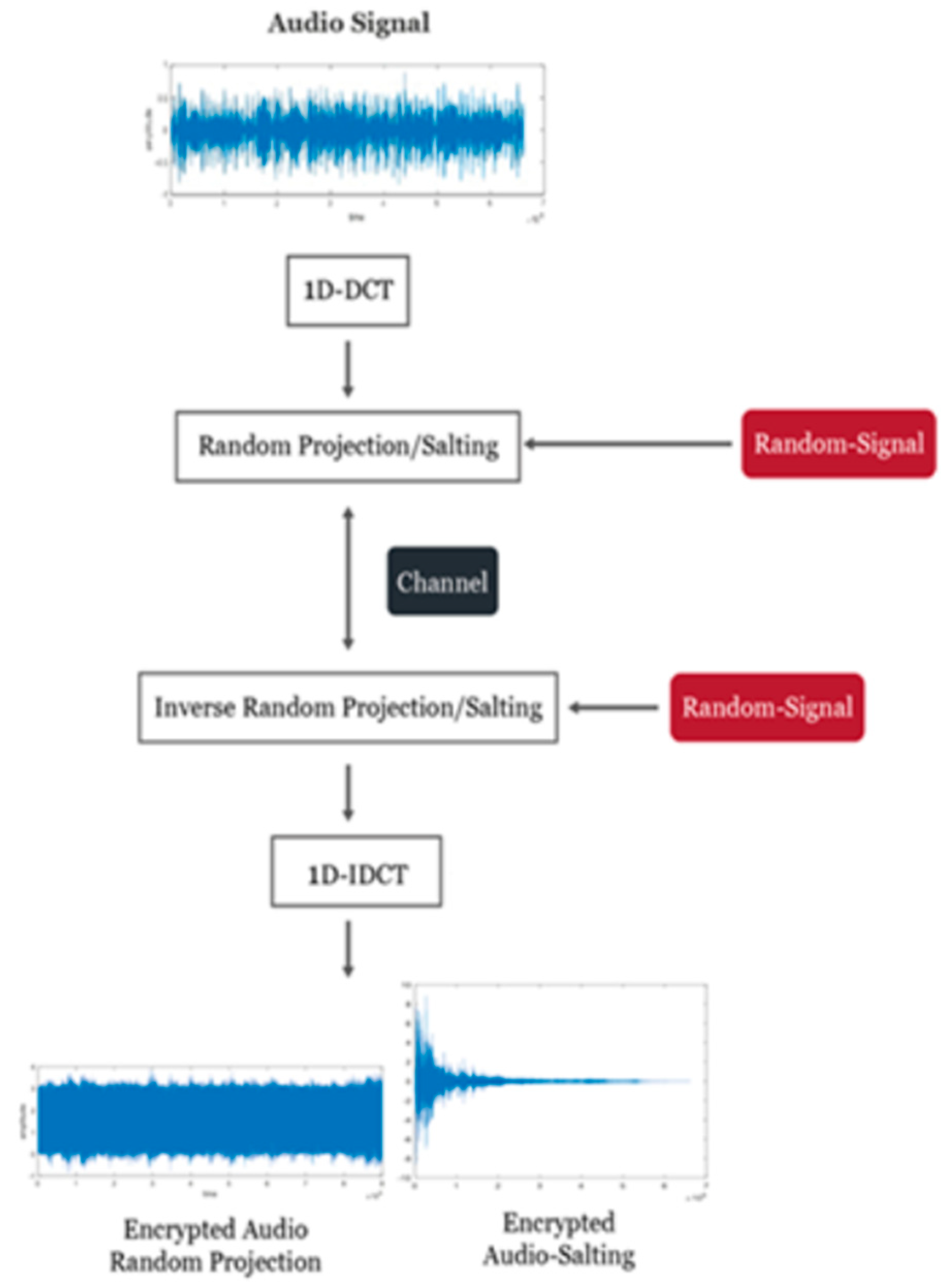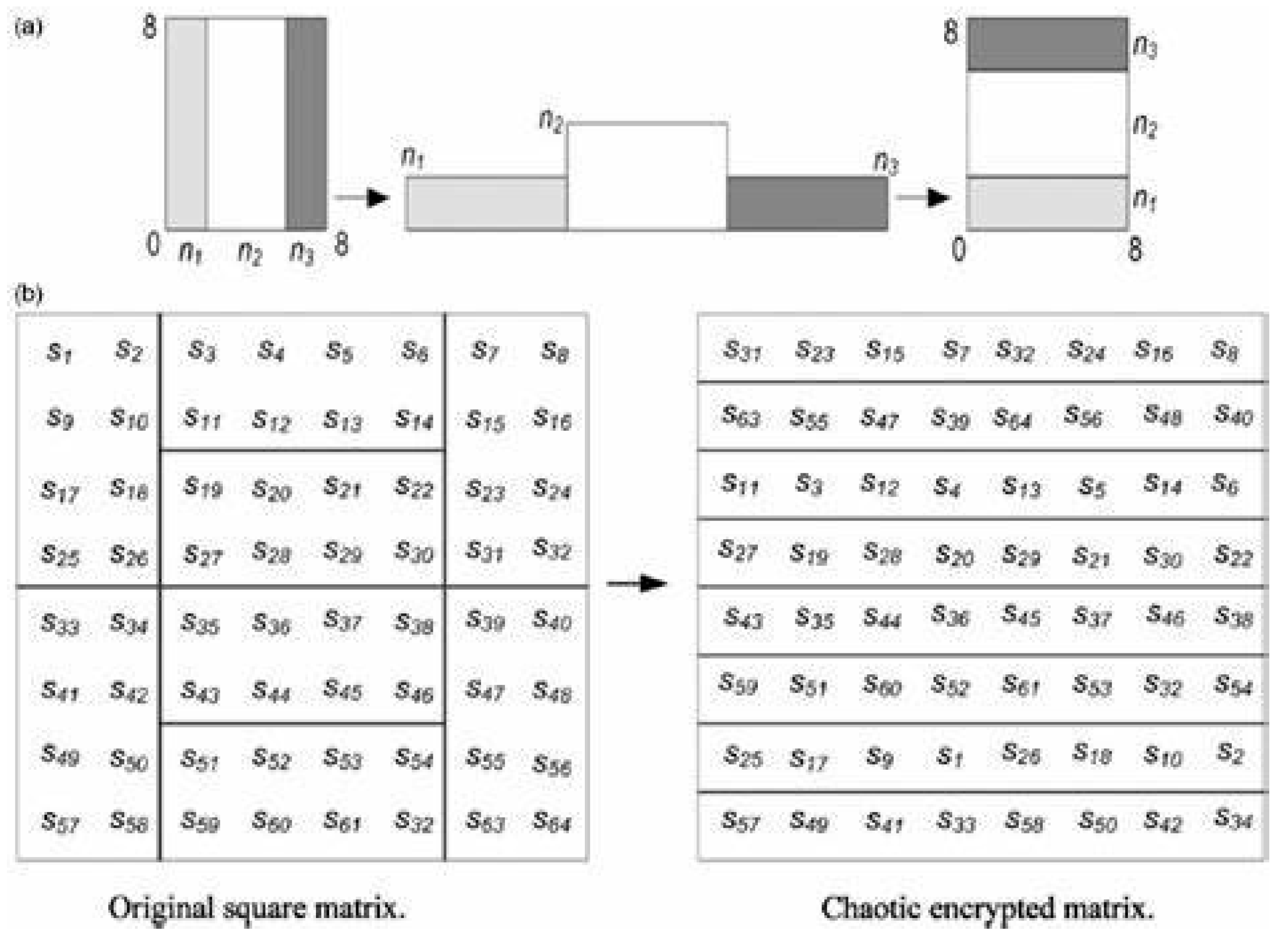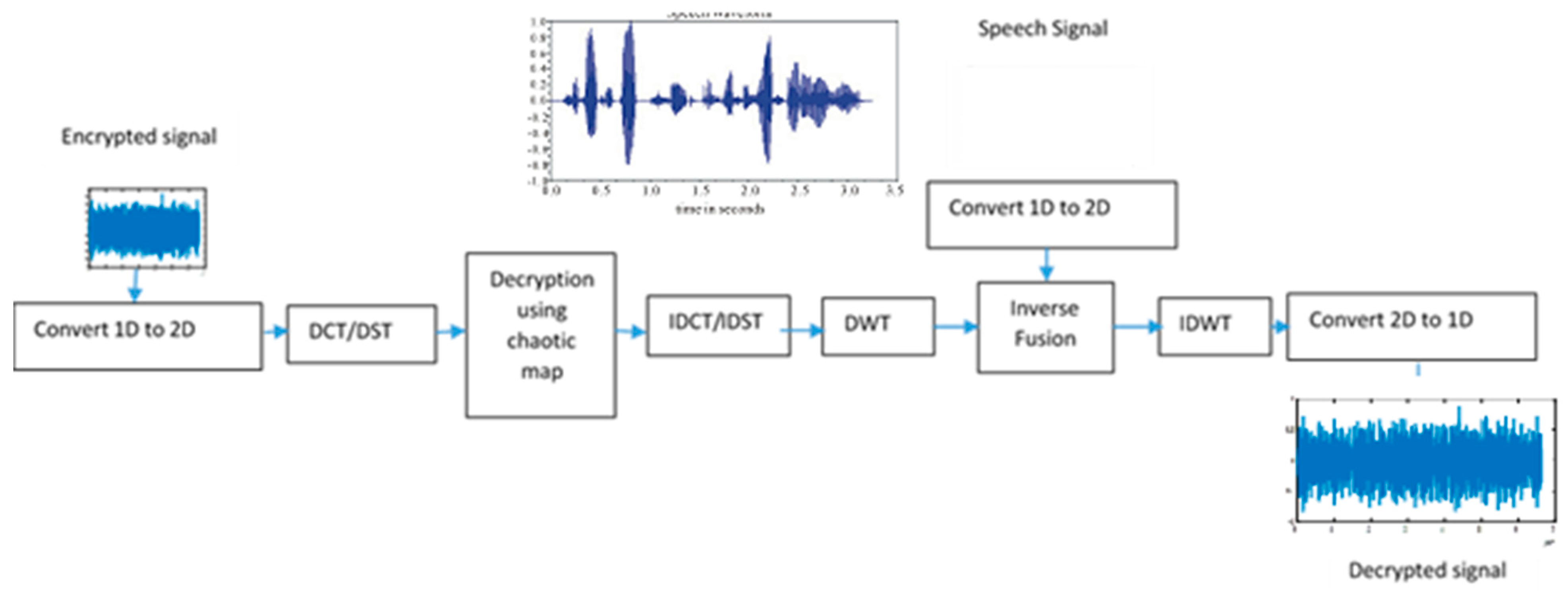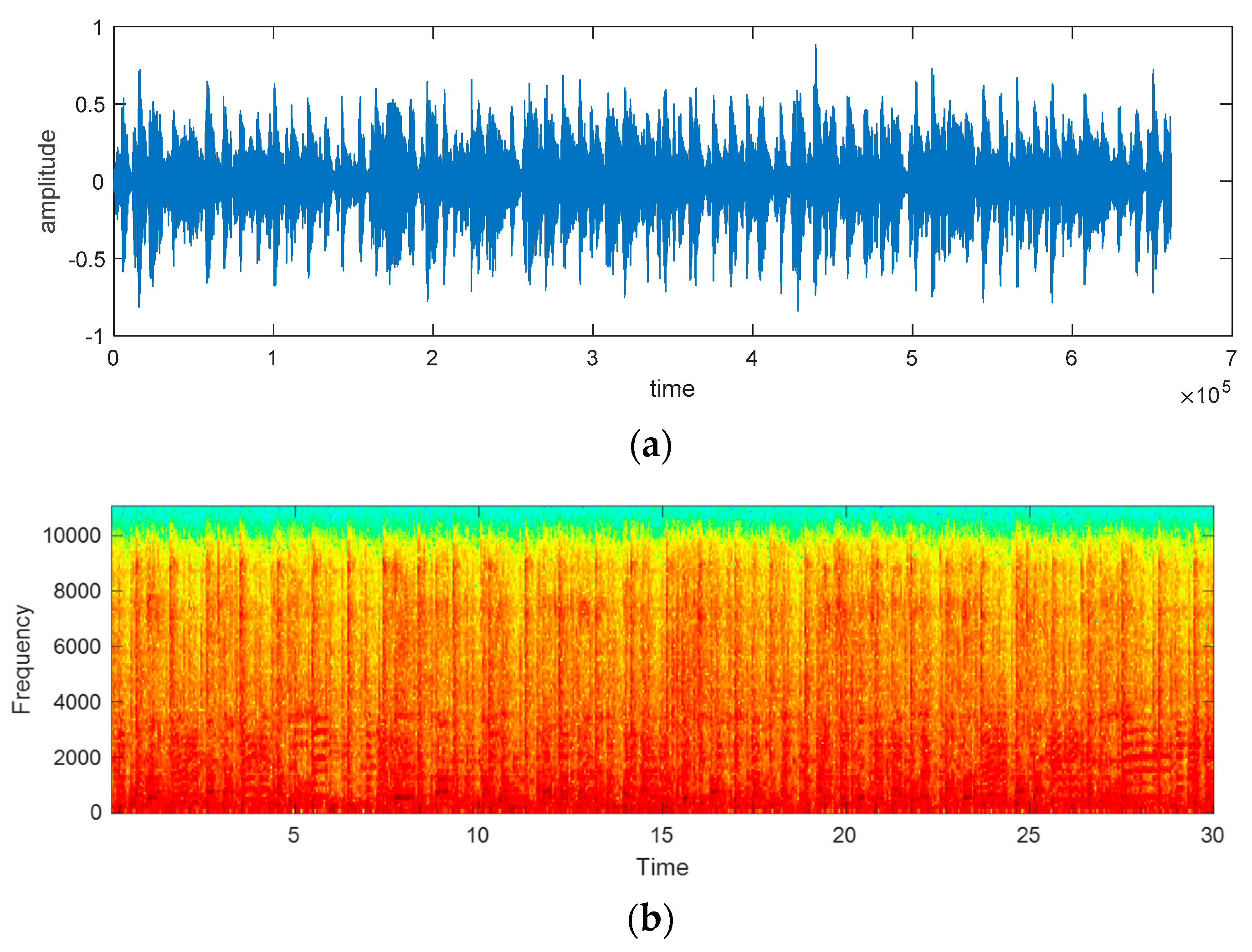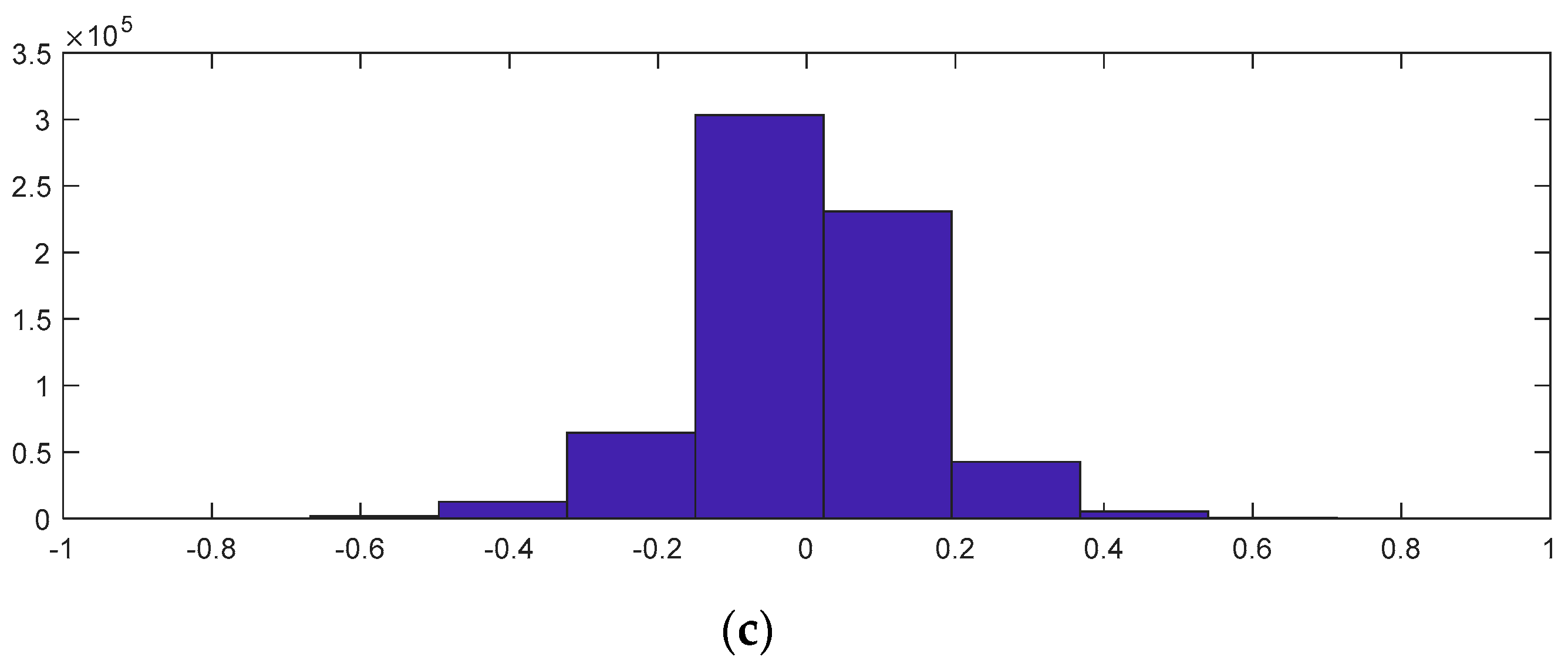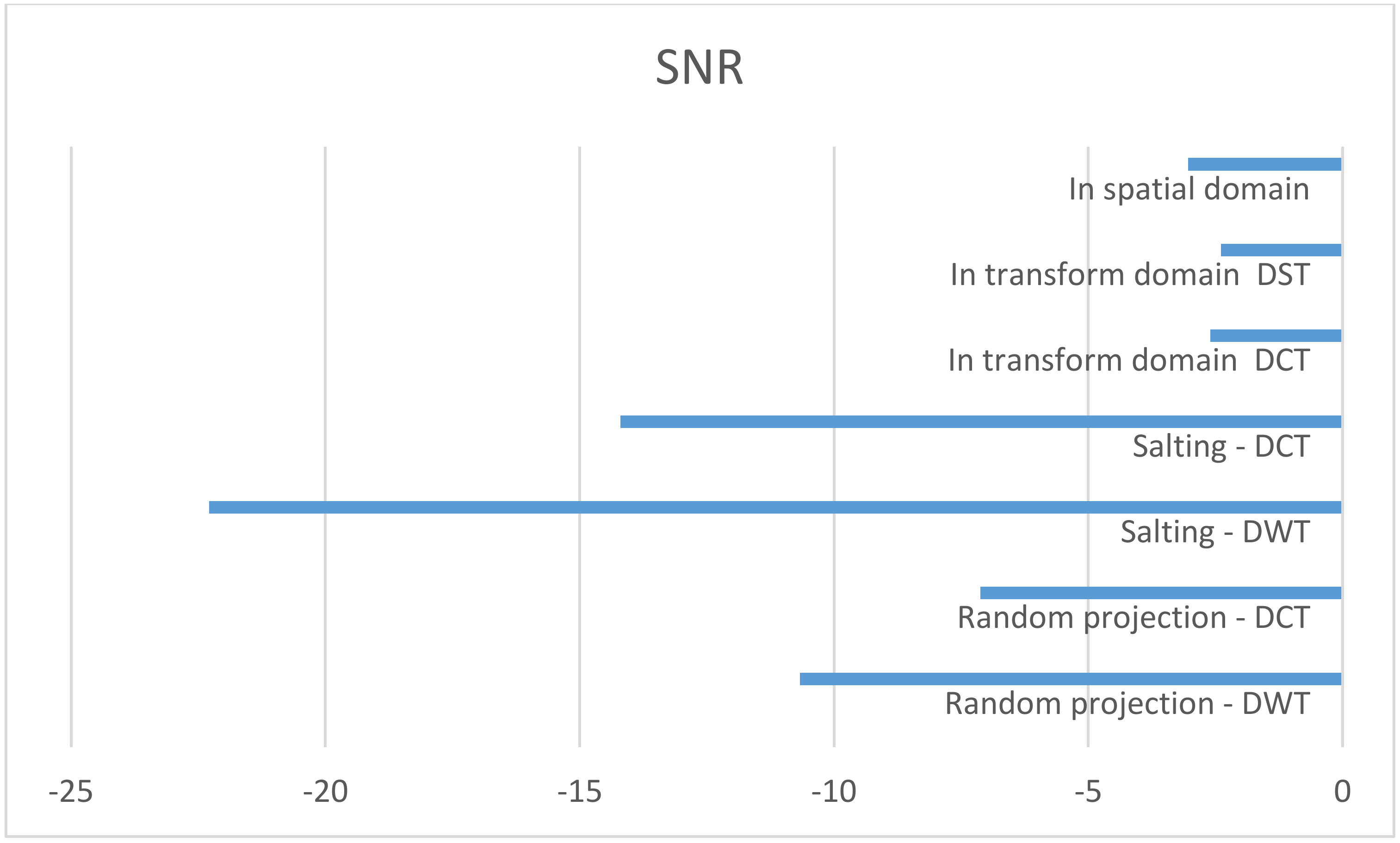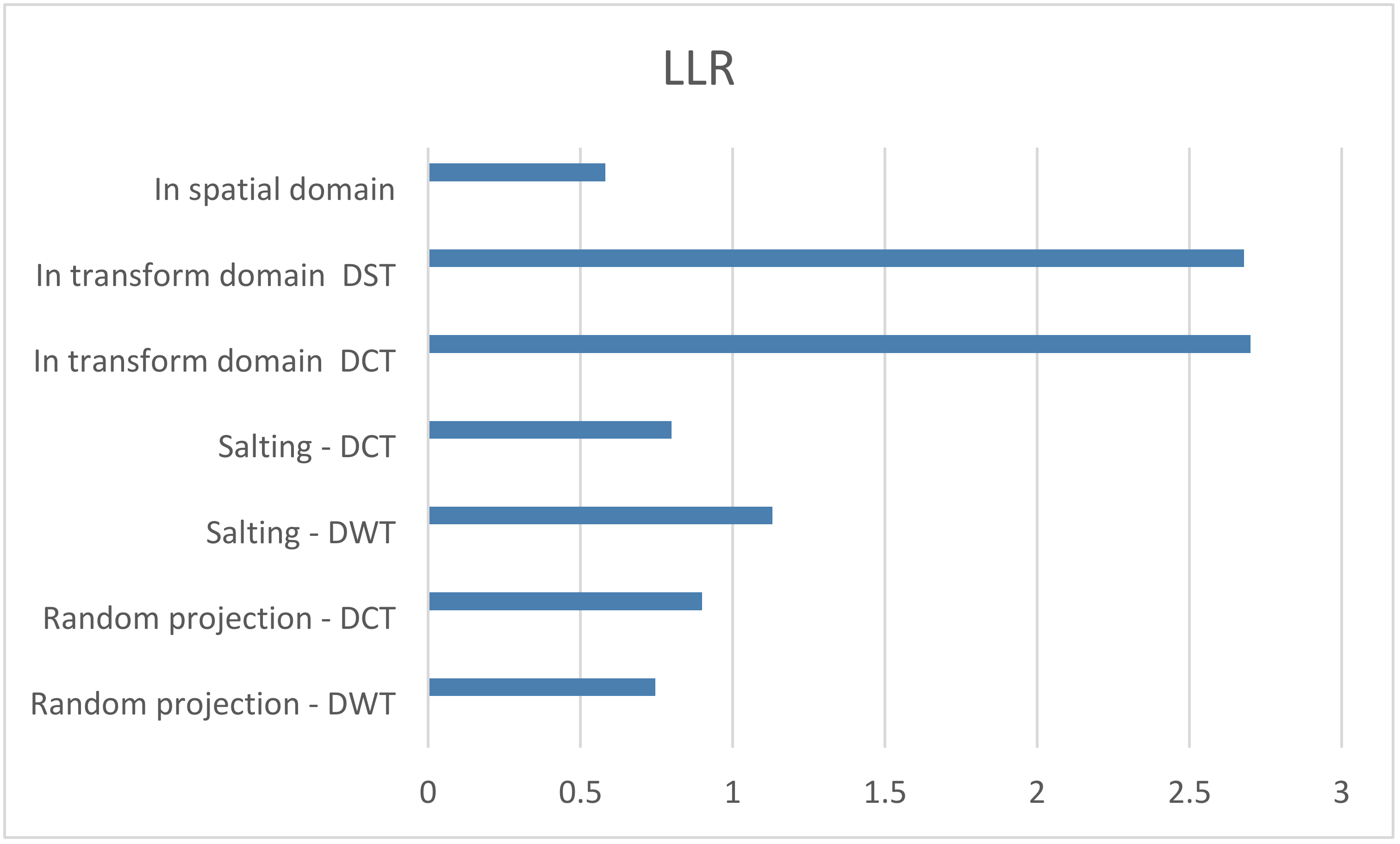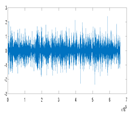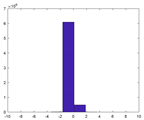1. Introduction
When transmitting data across communication channels, security and privacy represent major challenges. Speech signals can be conveyed via numerous means, such as telephone networks and private or public radio networks. Over time, speech has become the most common method of human interaction among all modes of communication. Speech communication is simple, natural, flexible, and efficient, which explains its widespread use and practicality. There are two possible ways to encode a speech signal: analog and digital. In an analog representation, the speech signal is viewed as a waveform that specifies the signal’s frequency and amplitude. In digital form, the speech signal is the numerical equivalent of the analog version, where the signal is encoded as a sequence of zeros and ones. Certain situations need the transmission of confidential information, including diplomatic and military communications during times of war and peace.
Because voice is so redundant when compared to written material, ensuring security is extremely difficult. Speech security can be achieved using either analog scrambling or digital ciphering; two distinct techniques. Speech scrambling has always piqued the interest of researchers due to its low-bandwidth consumption, ease of implementation, and effective handling of asynchronous transmission.
Speech codes are used in digital telecommunication networks to reduce the required transmission bandwidth. Other vocoders such as LPC-10 (Linear Prediction Coding), CELP (Code Excited Linear Prediction), MELP (Mixed Excitation Linear Prediction), and others have been developed. The most secure communication systems are built on LPC techniques. The main reason for this is that LPC voice coding ensures low bit rates and excellent voice clarity. Cryptographic algorithms frequently have stringent implementation criteria, such as minimal resource use, reduced memory, and logic gate count, and efficient power use. Designing systems that meet all of these needs in this context is a difficult task that requires extensive research.
More specifically, an implementation must be fast enough to avoid a significant slowdown in the system caused by the operation of cryptographic methods. Because software implementations have shown to be unable to deliver the required level of performance at an affordable price, hardware acceleration is adopted to accomplish this [
1,
2].
Only a small portion of available resources are dedicated to cryptography, making it difficult to develop high-security methods.
Real-time processing is an essential requirement for secure voice communications. In this case, the task of framing the incoming data becomes vital. It is crucial to strike a balance between the block size and all other elements since depending on the sampling rate, either short or large buffers may result in buffer overflows and delays. Because of their complexity, cryptographic algorithms need to be implemented on flexible platforms to meet real-time voice encryption requirements.
To improve security and address issues with existing techniques, we suggest investigating the use of multilayer encryption (fusion, substitution, and permutation) to achieve greater privacy by increasing confusion, which complicates the relationship between original and encrypted signals. The main contributions of this work can be summarized as follows:
- -
The encryption of audio signals using random projection and salting in the time domain and frequency domain.
- -
The encryption of audio signals using three layers of encryption that include fusion, substitution, and permutation in the frequency domain.
The following outlines how this paper is organized.
Section 2 introduces the related work on audio signal encryption.
Section 3 presents the proposed audio cryptosystems. The experimental study, simulation results, and discussion are included in
Section 4. Finally,
Section 5 summarizes the work and provides the concluding remarks.
2. Related Work
As mentioned previously, several attempts for audio data encryption have been proposed. For instance, numerous studies have examined audio encryption algorithms with the ultimate goal to achieve a good balance of speed and security [
3]. Sharma et al. [
4] developed a method for encrypting audio recordings with the RSA algorithm. Several algorithms, such as those outlined in [
5], encrypted text files and images using a variety of shuffling techniques. The RSA algorithm was used to encrypt speech files with each word extracted and translated to text, as described in [
6]. Using a chaotic map, several encryption keys are generated and used during each iteration of the encryption process, as in the chaotic audio encryption approach described in [
7]. Five steps were employed to implement the audio encryption technique; these phases use various diffusion and table substitution algorithms to encrypt audio data without data loss [
8]. To reduce the time required for audio encryption, the authors of [
9] recommended employing the discrete Fourier transform to encrypt selected parts of the audio stream.
In [
8], the dual-channel audio data is encrypted with a one-time key using a chaotic system with both the confusion and diffusion technique. To guard against brute-force attacks, the approach uses a big keyspace. Block by block, the cosine number transformation has already been used to generate a secret key from non-compressed 16-bit audio data [
10]. The sequence is based on a narrative that combines Henon and economic maps. When computing encrypted audio data, the confusion and diffusion technique is repeatedly used to encrypt plain audio data [
11]. Audio data has also been confused and disseminated using DNA coding and chaotic systems. The chaotic system’s initial value is calculated using the hash value of the audio [
12], the audio signal is transformed into data using a lifting wavelet methodology in a new encryption method, and it is then encrypted using a chaotic dataset and a hyperbolic function. Block-by-block encryption for audio files uses the principles of a block cipher and chaotic maps. In the permutation stage, a chaotic tent map is utilized. After that, a key block and the obtained block were XORed. The multiplication inverse-based method of substitution is used to replace the resultant block [
13]. With self-adaptive scrambling, chaotic maps, DNA coding, and cipher feedback mechanisms, a novel audio transmission technique is discussed. A pseudo-random number is produced by combining five separate chaotic maps and eight control settings [
14]. The chaotic circle map and modified rotation equations are utilized to produce the pseudo-random number in a proposed encryption technique for audio data [
15]. The permutation of audio samples using a discrete modified Henon map, followed by a substitution operation, is used to create a proposed audio encryption method. The modified Lorenz–hyperchaotic system yields the keystream. To assess the quality of the encryption method, many quality criteria have been established [
9]. The use of numerous chaotic maps and cryptographic protocols is described as a novel approach to voice signal encryption. The input signal is separated into four parts using a cubic map as part of the scrambling procedure. The blowfish algorithm is used in combination with the private key to protect all of the chaotic map parameters. The blowfish key of the system and the hashing algorithm are implemented between the sender and receiver endpoints. The message digest is used to authenticate and verify the chaotic map parameters during secure communication. To demonstrate the effectiveness of the technique, several statistical tests are conducted [
16]. A chaos-based cryptosystem was used to develop a novel multiuser speech encryption technique. Chua chaotic systems are used in transmitters and receivers to generate chaotic encryption and decryption keys. The XOR operation is combined with a chaotic matrix operation for randomization to encrypt the speech stream. The security analysis demonstrates the vulnerability of secret keys and the need for a large key space to withstand a brute-force attack. Strong diffusion and confusion processes have increased the battery life of the transmitter [
17].
A novel audio encryption system has been investigated using a substitution–permutation algorithm and DNA encoding [
18]. As part of the key generation process, the chaotic logistic map generates a new key block for each plain block. Several security assaults are carried out to evaluate the system. A cycle attack, selected plaintext attacks, and chosen cipher text are all successfully demonstrated [
18]. Effective cryptography is required for secure communication to exhibit confidentiality, privacy, efficiency, and accuracy. The security considerations and methods incorporated into the design and implementation of the most popular symmetric encryption algorithms were examined. Researchers estimated and compared the performance of various encryption algorithm parameters, including encryption and decryption times, throughput, key size, the avalanche effect, memory requirements, correlation assessment, and entropy, to determine which encryption algorithm is best for each application. With the use of a substitution–permutation algorithm and DNA encoding, a novel audio encryption system has been investigated. With the chaotic logistic map, a new key block is created for each plain block as part of the key generation process. To assess the system, several security assaults are carried out. A cycle attack, the selected plaintext attacks, and the selected cipher text are all successfully shown [
18]. Effective cryptography is necessary for secure communication to have the properties of confidentiality, privacy, efficiency, and correctness. The security considerations and procedures addressed in the design and implementation of the most widely used symmetric encryption algorithms were examined. To determine which encryption algorithm is best for each application, researchers estimated and compared the performance of various encryption algorithm parameters, including encryption and decryption times, throughput, key size, the avalanche effect, memory requirements, correlation assessment, and entropy.
The study described in [
19] proposes a new chaotic one-dimensional map. The second hyperbolic tangent term in this connection is delayed to prevent dynamical degradation. The map’s consistent chaotic behavior for practically all parameter values is demonstrated by computing its bifurcation diagrams and Lyapunov exponent diagrams. The suggested map is then used to construct a high-key space pseudo-random bit generator. Then, using this generator as a foundation, a proposed password generator application is built. The goal of this program is to develop an algorithm that takes a user-supplied, easy-to-remember key as the input and generates a strong password suitable for website security or file security.
The authors of [
20] propose a brand-new, straightforward chaotic one-dimensional map. The chaotic properties have been declared using Lyapunov exponent analysis and bifurcation analysis. They also propose a new picture encryption scheme based on this novel chaotic map. The shuffling algorithm and the substitution method both use this map. According to numerous statistical tests and security analyses, this approach has outstanding security performance and can compete with certain other recently presented picture encryption algorithms.
Authors of [
21] investigate the problem of chaos-based image encryption. The first step is to create and investigate a generalization of the one-dimensional chaotic map proposed by Talhaoui et al. in
The Visual Computer. The generalized map, like the original image, depicts areas of persistent chaos. Using the new map, a statistically safe pseudo-random bit generator is created and used in the encryption procedure. To introduce an image encryption technique based on rearranging the bit levels of an image, the bits are first organized into a three-dimensional matrix, and then a three-level shuffling is applied to each row, column, and bit level of the 3D matrix. After the bits have been shuffled, they are subjected to an exclusive OR operation.
In light of the provided literature review, we were motivated to develop a multilayer encryption system to increase privacy.
To the best of our knowledge, no prior research has investigated the impact of using layers of encryption. The main contributions of this study are described in the following section.
3. Proposed Approaches to Multilayer Audio Data Encryption
In the following proposed cryptosystems, audio signals and personal data are encrypted before being transmitted over wireless networks. The encrypted information can either be used as-is for authentication in cancelable biometric applications at the receiving end, or it can be recovered using a secret key and a decryption algorithm to be used for additional audio analysis. In this research, we consider the discrete wavelet transform (DWT), the discrete cosine transform (DCT), the discrete sine transform (DST), random projection, salting, and the chaotic baker map. As depicted in
Figure 1, these methods are arranged into three-layer encryption systems where numerous combinations are investigated. The cryptosystems alleviate the issue of audio low-activity intervals by combining the audio signal with a speech signal that lacks silence periods. The audio signal and the speech signal undergo preprocessing to meet the fusion requirements. During the preprocessing phase, the audio signal is converted from a one-dimensional to a two-dimensional signal. The 2D DWT is then applied to the audio signal. The same approach is used for the speech signal. In the proposed cryptosystems, the first layer is a fusion layer that employs either random projection or salting. The second layer is a substitution layer based primarily on the DCT or DST techniques. The third layer is a permutation layer that uses the chaotic baker map. Before delving into these strategies, we outline the overall structure first. The idea behind proposing a three-layer system is to strengthen audio signal security and preserve privacy and confidentiality. As seen in
Figure 1, audio and speech input signals are transformed into 2D signals prior to DWT processing. The two signals are subsequently fused using either random projection or salting. The result of applying an inverse DWT (IDWT) on the fused signal is sent to the next layer for the second level of encryption using a substitution operation with DCT or DST. The result of the substitution is then sent to the permutation layer using a chaotic baker map for the third level of encryption. In order to obtain the encrypted signal, an inverse DCT (IDCT) or inverse DST (IDST) is performed at the end. Algorithm 1 outlines this process. In
Figure 2 and
Figure 3, the various combinations of fusion with random signal and substitution layer approaches are shown.
Figure 2 depicts the use of DWT with random projection or salting, whereas
Figure 3 depicts the use of DCT with random projection or salting. Further details concerning the proposed strategies follow.
| Algorithm 1: Encryption |
| Input: Original audio signal and speech signal |
| Output: Encrypted audio signal |
Begin:
1-Get audio signal.
2-Get speech signal.
3-Preprocess the two signals by converting them to 2D signals.
4-Apply 2D DWT to the 2D signals to decompose each signal into four subbands.
5-Apply fusion using random projection by multiplying the coefficients of the subbands of the two signals or applying salting by adding the coefficients.
6-Apply IDWT to the results of random projection or salting.
7-The results of step 6 undergo a DCT or DST to replace the values with the frequency coefficients.
8-The coefficients from step 7 are permuted using the chaotic baker map with key
S_key = [n1, n2, n3] = [2, 4, 2].
9-Apply the IDCT or IDST to the output of step 8 results.
10-Convert the 2D signal obtained in step 9 to a 1D signal to obtain the encrypted audio. |
| End |
3.1. Random Projection Based on 1D-DWT/1D-DCT
The proposed algorithm for audio signal encryption based on random projection in the DWT domain is illustrated in
Figure 2. The block diagram suggests combining the 1D DWT of the audio signal with a random signal.
The DWT first divides the signal into an approximation signal obtained by using a low-pass filter (L) and details obtained by using a high-pass filter (H). The details represent the high-frequency component, while the approximation is the low-frequency component. The audio signal is split into two sub-signals, each half its original length, by the DWT. One sub-signal is a running average or trend (L), and the other is a running difference (or fluctuation) (H). To generate a random signal, the audio signal is divided in half.
The random projection transformation is then used to encrypt the wavelet coefficients. Random projection transformation is frequently used for cancelable biometric templates [
22]. “Random projection” refers to the act of projecting the original signal or feature vector onto a random space. It can be implemented by multiplying with a random matrix. For example, a random matrix
F can be used to multiply the vector of an audio signal,
L, to produce a random vector,
L*. Also, a random matrix
F can be used to multiply an audio signal’s vector,
H, to produce a random vector,
H*, as can be seen in Equation (1) where
k and
d refer to the dimension of the matrix.
The wavelet coefficients of an audio signal are transformed into a random signal using this method. The encrypted audio signal is created after the random projection transformation. As a result, the relative separations between any two samples in the encrypted audio signal space are preserved in the output random space. Then, at the receiver, the audio signal is subjected to the inverse random projection transform in preparation for further processing. Finally, the inverse DWT method is used to reconstruct the original audio signal so that it can be compared to those in the database if used for authentication.
Another combination is considered in our study. As illustrated in
Figure 3, the discrete cosine transform (DCT) can be used in place of the DWT. In this case, the random projection algorithm is used to encrypt the DCT coefficients.
3.2. Salting Based on 1D-DWT/1D-DCT
Figure 2 and
Figure 3 show the other combinations considered in our study, where the fusion rule is achieved this time through salting. Depending on the type of random sequence, the salting process involves adding a random sequence to the audio stream or its extracted features (Gaussian or uniform). The noise power affects the performance of the salting-based technology. This method entails blending a pattern with the original audio pattern’s DWT or DCT elements. The mixed patterns may contain pure random noise or artificial patterns. The relative strength of the noise patterns influences the cryptosystem’s effectiveness. As a result, picking a pattern with a lot of actions makes sense. Using a simple subtraction technique, the original audio signal is extracted at the receiver for further processing.
3.3. Permutation Using Chaotic Baker Map
The third method in the suggested cryptosystems for permuting the coefficients from layer 2 to obscure the output of the second layer is the chaotic baker map. The horizontal and vertical stretching and folding of the coefficients provide the foundation of the baker map. The positions of each coefficient in the output of the second layer are changed by repeating this process. More specifically, the chaotic baker map is a two-dimensional map that shifts each square matrix element [
23]. These maps are used to nonlinearly randomize the elements of the square matrix in a framework that is sensitive to the initial conditions. To achieve confusion and diffusion, cryptosystems must be extremely sensitive to the starting conditions. The two key properties of the chaotic baker map are as follows:
Its output is highly random, unpredictable, and correlated little with the input.
It is highly dependent upon the input parameters, starting values, and early conditions.
Let
B (
…
) denote the discretized map, where the vector [
…
] represents the secret key,
. Defining
N as the number of data items in one row, the secret key is chosen such that each integer
divides
N, and
+ … +
=
N. Let
=
+ … +
, The data item at the indices (
q,
z), is moved to the indices: as shown in Equation (2).
where
≤
q <
+
, and 0 ≤
z <
N.
The chaotic permutation is performed in the following steps:
An N × N square matrix is divided into k rectangles of width and the number of elements N.
The elements in each rectangle are rearranged into a row in the permuted rectangle. Rectangles are taken from left to right beginning with upper rectangles and then lower ones.
Inside each rectangle, the scan begins from the bottom left corner toward the upper elements.
Figure 4 below shows a popular example that explains how permutation is performed for a chaotic map of an (8 × 8) square image (i.e.,
N = 8). The secret key,
= [
n1,
n2,
n3] = [2, 4, 2].
3.4. Decryption Process of the Proposed Three Layers Technique
The inverse of the encryption process is used in the decryption algorithm. As shown in
Figure 5, the encrypted signal is transformed using DCT or DST and the resulting coefficients are passed through a pipeline that begins with chaotic decryption followed by an inverse discrete cosine transform or inverse discrete sine transform, then DWT. After this stage, inverse fusion is performed, whereas in salting, we subtract the speech coefficients from the audio coefficients (in case of a random projection we apply division), then an inverse DWT is applied, and finally, a conversion operation is performed to obtain the decrypted signal.
4. Simulation Results and Discussions
In order to evaluate the proposed cryptosystems, the performance of each technique was evaluated in a simulated environment using MATLAB. We also considered logistic map encryption, which is used in many comparable publications, for comparison purposes. The logistic map is one of the traditional chaotic maps that can be used to generate keys for an encryption scheme [
24]. The 1D logistic map is defined as follows:
where
is the initial state, m is the number of iterations and h is a system control parameter with values ranging from 0 to 4, and
has a value range of 0 to 1 for all values of m. The value of h determines how the logistic map behaves. As the repetitions become entirely chaotic, h is chosen for encryption purposes to be 3.57. There are different behaviors of x depending on the h value. The 1D logistic map system is used to construct the new S-Box used to permute samples.
Due to the 1D logistic map’s limitations, a modified 2D logistic map has been developed for encryption. It is defined as follows [
24]:
4.1. Statistical Metrics
Each signal in the database has an average runtime of 3 min and a 360 Hz sampling frequency. Various measurements and viewpoints have been taken into account during the performance analysis process.
To evaluate the quality of the encryption and decryption processes, histograms of the encrypted and decrypted signals were calculated.
Table 1 illustrates this comparison. It is important to note from
Table 1 that both the proposed random projection based on 1D DWT and the cryptosystem based on three layers provide uniform histograms for the encrypted signals. These methods are hence resistant to statistical attacks. Unfortunately, the random projection based on DCT, salting, and logistic map encryption has histogram distributions that are not uniform enough, making them less resistant to histogram-based statistical assaults.
SNR, SNRseg, LLR, and spectral distortion are examples of quality measures that can be used to assess the effectiveness of audio signal encryption (SD). Based on the original and encrypted audio signals, all of these parameters can be approximated. The quality of the encryption increases with decreasing SNR and SNRseg. Additionally, the encryption quality improves with greater LLR and SD values. We represent SNR in Equation (6), and we suggest referring to [
25] for further details.
where
x(
n) is the plain audio signal,
y(
n) is the encrypted signal, and n is the time index.
Figure 6 shows the original audio, histogram, and spectrogram of the audio signal, whereas
Figure 7 depicts a comparison of the proposed encryption techniques in terms of SNR. The suggested salting-based encryption technique and the three-phase DCT/DST cryptosystem provide the highest level of security compared to the other approaches since they achieve the lowest SNR values (−25 dB and −2.5 dB, respectively).
Over a brief frame of the predefined signal, the average SNR values can be determined. SNRseg is a well-known metric that uses the following Equation (7) to compute the average SNR values for a given signal over a particular period of time.
where
M is the total number of frames in the audio signal, and
N is the frame duration which can be set between 15 and 20 ms.
The log-likelihood ratio (LLR), an objective metric described in [
26], is based on the distance between two vectors of linear prediction coefficients (LPC) computed on plain and encrypted signals. It can be calculated using the following mathematical equation:
LPC coefficients for the original audio signal are (), and those for the encrypted audio signal are (). The autocorrelation matrix for the original audio signal and the encrypted audio signal are determined by the values of () and (), respectively.
The LLR values of the suggested alternatives in comparison to the logistic map encryption method are shown in
Figure 8. The suggested three-phase cryptosystem offers the maximum level of encryption since, when compared to the other systems, it obtains the highest LLR value.
The spectral distortion (SD), which has maximum values of 44 to 45, indicates how much the encrypted signal spectrum differs from the original signal spectrum. In the frequency domain, it is calculated as:
where
and
represent the spectrum of the original and encrypted audio signals, respectively; greater simple signals result in a smaller SD value.
Figure 9 compares several encryption methods in terms of SD values. It is apparent that the SD value of the 1D-DWT random projection, which achieves the most spectral distortion during the encryption process, yields the best results. Accordingly, the correlation between the original and encrypted audio signals is evaluated in order to determine how well the cryptosystem works:
The correlation between the decrypted signal y and the original signal x is denoted by
while c
v(x,y) refers to the covariance between them. The variances of these signals are represented by D(x) and D(y), respectively. Further details on this measure can be found in [
26]. The lower the value of the correlation coefficient r, the better the performance of the encryption.
Table 2 compares the normal and encrypted audio signals in terms of SNR, r, SSIM, SD, SNRseg, and LLR. Similar comparisons are conducted between plain and decrypted signals, as shown in
Table 3, in order to determine how effectively the encryption systems perform after being decrypted
The three suggested options offer high levels of security, as shown in
Table 2, where the correlation values are near zero. However, the logistic chaotic encryption yields a correlation of just 0.48. The correlation values between the original and decrypted audio signals equal 1, as given in
Table 3, further demonstrating the high quality of the decrypted audio signals. These tables reveal a significant discrepancy between the original and encrypted signals, revealing remarkably low SNR values. The findings demonstrate close to zero values for r, low values for SNR, and SSIM, big values for LLR, and high values for SD. These results confirm that the suggested audio encryption methods are extremely effective.
4.2. Infiltration of Encrypted Signals
Noise attack is a considerable risk when the encrypted signals are transmitted through a communication channel. This section analyses how noise attacks impact the suggested approaches.
Here, the encrypted signal is subjected to salt and pepper noise with a variance equal to 0.019. The impact of noise on the decrypted signal is seen in
Table 4. The noise disrupted the decryption process and the recovered signals suffered from data loss as a consequence.
Table 5 displays the outcome of the cropping experiment using 40% of the encrypted signal. Contrary to salt and pepper noise, cropping was considerably less impactful. According to
Table 4 and
Table 5, the random projection based on 1D DWT and the three-phase encryption cryptosystem record the best results, demonstrating that these two systems are highly resistant to noise attacks.
4.3. Performance Comparison of Audio Encryption Algorithms
In this section, we provide a comparison of audio encryption techniques from the literature in terms of correlation (r) and SNR.
Table 6 displays the results of this comparative study.
As shown in
Table 6, the proposed encryption methods achieved competitive results compared to the state-of-the-art methods showing low scores for both correlation coefficient r and SNR. The best score in terms of correlation score is obtained with the logistic map. However, its SNR score is not the best. The results clearly show that the proposed methods achieved a better balance in terms of r and SNR. Because the correlation scores are so low, we can conclude that a statistical attack by an intruder will not reveal any valuable data. On the other hand, the algorithm’s SNR results are low, implying that the proposed algorithms have a lot of noise, making them more attack-resistant.
4.4. Signal-to-Noise Ratio between Plain and Encrypted Audio Files
Since the employed measures show low SNRs, it is clear from
Table 7 that all test findings show that the audio encryption technique is secure. According to
Table 7, all of the observed SNR values are negative, indicating that the encrypted files are extremely noisy and that the encryption approach has entirely destroyed the clear signal in the plain audio files.

